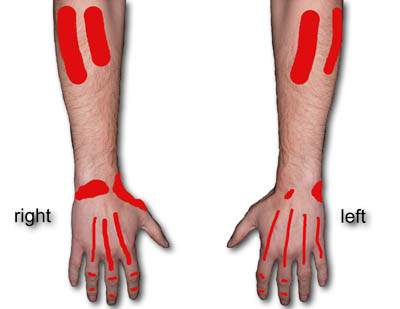 An RSI (Repetitive Stress Injury) occurs when stress is placed on a joint, pulling on the tendons and muscles around the joint. When the stress occurs repeatedly, the body does not have time to recover and becomes irritated. The body reacts to the irritation by increasing the amount of fluid in that area to reduce the stress placed on the tendon or muscle. If not treated, it can lead to injuries to the soft tissues, tendons/muscles, and nerves.
An RSI (Repetitive Stress Injury) occurs when stress is placed on a joint, pulling on the tendons and muscles around the joint. When the stress occurs repeatedly, the body does not have time to recover and becomes irritated. The body reacts to the irritation by increasing the amount of fluid in that area to reduce the stress placed on the tendon or muscle. If not treated, it can lead to injuries to the soft tissues, tendons/muscles, and nerves.
Some conditions that are the result of RSIs include:
Carpal tunnel syndrome: swelling inside a narrow “tunnel” formed by bone and ligament in the wrist; the tunnel surrounds nerves that conduct sensory and motor impulses to and from the hand, leading to pain, tingling, and numbness.
Lateral Epicondylitis: term that describes soreness or pain on the outer (lateral) part of the elbow. Commonly referred to as “tennis elbow”. Ganglion cyst: swelling or lump in the wrist resulting from jelly-like substance that has leaked from a joint or tendon sheath.
Trigger Finger: limits finger movement. When you try to straighten your finger, it will lock or catch before popping out straight.
DeQuervain’s Tenosynovitis: Pain along the back of the thumb, directly over two thumb tendons, and pain may extend to the forearm.
Cubital Tunnel Syndrome: the effect of pressure on the ulnar nerve, one of the main nerves of the hand. It can result in a variety of problems, including pain, swelling, weakness or clumsiness of the hand and tingling or numbness of the ring and small fingers. It also often results in elbow pain on the side of the arm next to the chest.
Tendonitis: Inflammation or degeneration (breakdown) of the soft tissue around muscles and bones.
It is vital to seek medical intervention if symptoms persist. The physician will do a thorough examination to diagnose the particular condition. He may recommend rest, and recommendations for modifying current activity level. He will routinely recommend a patient to hand therapy for appropriate treatment including use of modalities and symptom control techniques as well as progression in gentle stretches, strengthening with individually tailored home program. The physician may also prescribe the certified hand therapist to fit a specific prefabricated splint or make a custom fabricated splint for maximum proper fit and protection to tailor each patient’s individual functional needs.
As part of the therapeutic program, the hand therapist will instruct you on tendon and nerve protection techniques, including ergonomic techniques and provide recommendations for your specific computer station.

